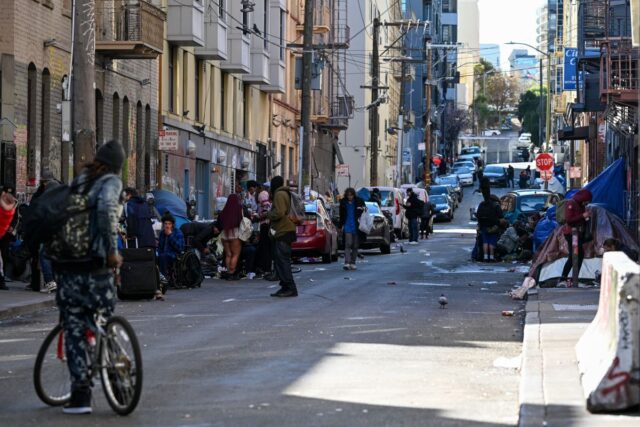A few months ago, I received an anonymous message containing a recording of a Dec. 20, 2023, phone meeting led by Dr. Hillary Kunins, Director of Behavioral Health Services and Mental Health SF, regarding harm reduction strategies for 2024. Attendees included San Francisco Department of Public Health (SFDPH) employees and nonprofit providers funded by the city to handle harm reduction initiatives. The 45-minute meeting centers on the group’s support for harm reduction and worries that funding won’t be there for their budgets. Both SFPDH and nonprofit providers lament the attitudes of San Francisco residents toward drug users. Kunins, in particular, is defiant and passionate, apologizing for “getting emotional” at one point.
“The topic of public … open-air drug use feels like is a driving preoccupation for the city,” Kunins says. “There’s also the issue of open-air drug selling, which I know are not unrelated .… As a longtime progressive advocate in public health, I have been pretty silent about this because I have always felt it’s about stigma and it’s about prejudice, and we should be protectors, and we are responsible for supporting people, and their public drug use is really a problem for other people.” Other people, meaning those who live and work in the city and see the carnage occurring on the streets, where two people per day die of drug overdoses. “I feel that we can’t get around saying something about this and obviously safe consumption is the solution and that can’t happen right now … this is also preoccupying us. I don’t have the specific answer but it’s been hard not to talk about this without having consumption spaces .…”
Prior to her appointment by former mayor London Breed on Jan. 27, 2021, Kunins, an internist and addiction medicine physician, served as Executive Deputy Commissioner of Mental Hygiene at the New York City Department of Health and Mental Hygiene where she oversaw “strategic and equity-driven initiatives to improve the behavioral health of all New Yorkers — including children, youth and families, and people who are justice-involved, who are experiencing homelessness, who live with developmental challenges, and who use drugs.”
As Kunins speaks on the call of nonprofit providers, all of whom praise her profusely for her brave leadership (keep in mind, they are dependent upon her for their money), the rallying cry is to continue pushing harm reduction on a city that has grown weary of the kid-glove handling of public drug use and sales. “This has really been a difficult time, and I really appreciate this group. There’s so much stigma — I’m getting emotional, so sorry,” Kunins says. “Like, to the extent of which you all showed up at that last hearing is extremely important. We’re planning to open a crisis diversion unit at Geary and Hyde … we’ll be having a community meeting, and getting people who are supportive at that meeting is extremely helpful.”
Eleana Binder, Public Policy Director at GLIDE’s Center for Social Justice, chimes in about funding worries for their harm reduction programs. Keep in mind that GLIDE had $18 million in revenue and total assets of $59.4 million for 2023, paying then-CEO Karen J Hanrahan over $805,000 in compensation. They also paid their retired late founder Cecil Williams over $285,000 and Chief People Officer Bernadette Robertson, over $250,000. GLIDE also paid over $1,300,000 to seven additional employees.
Beyond worrying about how much taxpayer money her organization will receive, Binder asks, “How can we as providers partner with the city to make sure public health intervention is prioritized rather than some of the criminalization that has been ramping up? Thinking about public messaging to promote the positive things that are happening.” Kunins says things like site visits are occasionally used “strategically” and that there are “people on this call who have been in San Francisco much longer [than I have] and know how to move those needles.” (I’m sure there was no pun intended.)
Kevin Liu, who works on harm reduction for Tenderloin Neighborhood Development Corporation, asks about a request for proposals (RFP) that went out to providers that could be up to $8 million. “Are there specific objectives attached to that we should know about?” Kunins laughs, “We are not allowed to talk about the RFP because it has been released, and it could be unfair to people not in this meeting who are potential applicants.”
Kunins stresses that for all nonprofit partners, “providing syringe services and other drug use equipment is part of the fabric of what should be considered substance use services .…” She explains, “The way the syringe services are funded is that San Francisco Aids Foundation is the lead, and they subcontract with GLIDE, Saint James, Homeless Youth Alliance. So, the Friday night shift will be covered either by the San Francisco AIDS Foundation or GLIDE. We’re working that out now, but there will not be any loss of services or any funding that will be lost.” The Sierra Health Foundation grant to Saint James will be going away because Saint James is going away, someone reminds Kunins, and there was HEP C funding to Saint James that will also be sunsetting.
At times the call veers into an almost cult-like anger toward the community. “We very much realize the scrutiny and the evidenced harassment you and all your colleagues are experiencing and I just wanted to acknowledge that,” Dr. Jeffrey Hom, Director of Population Behavioral Health for SFDPH says, his voice shaking with anger. Wes Saver, Senior Policy Manager at GLIDE, chimes in, “I really hate that you all have to be so careful with your language around harm reduction — you shouldn’t have to make it your job to make other people feel good about being dangerously ignorant and wrong.”
Kunins adds, “I’ve met with a smaller group of you about the language around harm reduction and the challenges that we, that I, am having in government,” she tells the group. “That it engenders very strong feelings in describing what that means as a strategy. If you all feel that we have stepped too far back from the term … I’ll say one more thing. I think people coming out and talking about their lived experiences as current or former users goes a long way in reaching the people we need to influence.”
Repeatedly, Kunins emphasizes the importance of having “clients” attend meetings and hearings, particularly before city officials, to sway them with their “lived experiences” because it is sometimes more effective than having people hear from nonprofits who receive millions in funding from the department. But Vitka Eisen, CEO of the controversial harm reduction nonprofit HealthRIGHT 360, isn’t a fan of that idea.
“Because we take a strong stance against coercive treatment, sometimes I try to use our contract to emphasize that we are motivated by care and not money,” she says. “I try to turn it on its head and say, ‘But wouldn’t we want that? It would drive more clients to us!’ But, of course, that’s not what we want because it’s not good care and it’s unsafe and it doesn’t work.” Eisen, who went through a 12-step program for her own addiction, tells Kunins that people who speak from lived experience “can be damaging … dismissive of things that are not 12-step. It can be a challenge.”
“As someone who is really outspoken about harm reduction … harm reduction, harm reduction, harm reduction … it’s really hard to get people to come in and talk about their experience. It’s no longer a war on drugs, it’s a war on science, and it makes me really crazy,” says Lydia Bransten, Executive Director of the Gubbio Project — but her real concern is about money, money, money. “My question is around the opioid settlement funds … we have in the ‘23-24 budget $11,000 set forth for the wellness center and neighborhood security … can we have a conversation about what is happening there? Are you looking to fund those of us doing the work right now?”
Bransten makes frequent media appearances asking for funding. When a safe consumption site in the Mission she counted on running didn’t open in 2023, she took to ABC7 News. “Those are people that are not sitting on the street. These are people who are able to rest .… But being able to translate that into funding has been really challenging,” Bransten told reporter Tara Campbell. “What we really need is … we need the San Franciscans who think that this organization is a value and that we’re doing work that matters and makes a difference for the people living on the street and the community we live in to support us.”
Bransten, a previous member of the Gubbio Project’s board, agreed to become its new director in 2021, stating she had “enough money in the nonprofit’s coffers to survive six months.” As of Aug. 10, 2022, Bransten listed a salary for herself of $80,398 and total salaries and other compensation as $427,528 — but total revenue was just $339,326, for revenue less expenses of negative $152,785.
Toward the end of the call, Jennifer Friedenbach, CEO of the Coalition on Homelessness, offers her two cents and, surprisingly, makes the most sense of anyone. “It would be more effective and efficient to go where people are already receiving services …” she says, then rambles on about “potential” and “spaces being ignored” and “the political thing is to open a new space” and having “already existing spaces that they should figure out rather than opening new ones, “especially in light of this current budget situation.”




